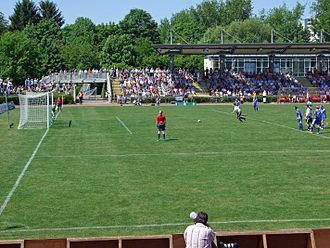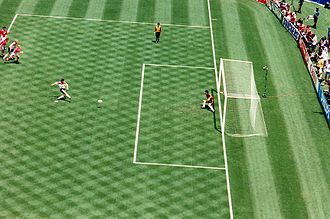Penalty kick (association football)
![]()
The title of this article is ambiguous. For other meanings, see Penalty kick (disambiguation).
![]()
Penalty is a redirect to this article. For the procedure for determining a winner in football, see penalty shootout.
The penalty kick (English, Swiss, also Austrian Penalty [ˈpɛnl̩tɪ] ( ![]() ), colloquially also called penalty kick, hand penalty, foul penalty or penalty) in football is a match penalty imposed by the referee instead of a direct free kick for the attacking team in the penalty area of the opponent. The penalty kick awarded in a match for a breach of the rules is distinguished from the penalty kick awarded as part of the procedure to determine a winner.
), colloquially also called penalty kick, hand penalty, foul penalty or penalty) in football is a match penalty imposed by the referee instead of a direct free kick for the attacking team in the penalty area of the opponent. The penalty kick awarded in a match for a breach of the rules is distinguished from the penalty kick awarded as part of the procedure to determine a winner.

Birgit Prinz in the 73rd minute taking the penalty kick for the 4:0 final score in the Bundesliga match Frankfurt - Potsdam, May 12, 2008

Lothar Matthäus converts a penalty kick in the 47th minute of the 1994 World Cup quarter-final against Bulgaria for a 1:0 lead.
Prerequisites and consequences
A penalty kick is awarded if the defending team commits a violation in its penalty area that would be punishable by a direct free kick in the rest of the pitch (usually a foul or a handball). The mere violation of the rules is sufficient, a special severity in the sense of a "penalty worthiness" is, contrary to what is sometimes heard in sports journalism, not a prerequisite. According to the rules in force since 1 June 2016, a penalty kick must also be awarded for offences committed by the defending team's player behind the goal line in the area of his own penalty area or if he throws an object (on or off the pitch) at an opponent who is in the penalty area. In addition, a penalty kick could also be taken by a team official interfering in the match or by a player of the defending team being permanently excluded. The decision to award a penalty kick does not change whether the referee must also award a personal punishment (a caution or - especially in the case of a so-called emergency stop - a sending-off) to the player who committed the offence.
A penalty kick often leads to a goal and can therefore be a game-changing situation. For this reason, players of the attacking team repeatedly try to feign a violation of the rules, for example by dropping themselves in the opponent's penalty area ("swallow"). Such an attempt is punished by the referee with an indirect free kick for the defending team, and the player who faked the infringement is also cautioned.
History
The penalty kick was invented in Ireland in 1891. It was invented by William McCrum, a linen manufacturer and sportsman who was goalkeeper for Milford Everton FC in the Irish Football League from 1890 to 1891. The penalty kick was intended as an equaliser when an opponent deliberately tripped or kicked. In the same year, the Irish FA proposed that the penalty kick be introduced across the board, and after some debate, it was.
In Germany the penalty kick was introduced in 1893. Initially, in both England and Germany, there was no penalty mark in the form of a point, but a line running parallel to the goal line at a distance of 12 yards (i.e. almost exactly 11 metres, which is where the common name comes from) from the goal across the entire pitch, this was also called the 'atonement line'. From everywhere on this line it was allowed to shoot at the penalty kick. The goalkeeper was allowed to stand up to five and a half metres from the goal line. In 1902, the penalty area (often referred to as the 16-yard area) was introduced and the atonement line was replaced by what is now known as the penalty spot, which is 12 yards from the centre of the goal.
Since 1906 the goalkeeper is not allowed to leave the goal line when taking a penalty kick. However, he was allowed to move on the goal line until the shot was taken, which was abolished in 1929, but has been allowed again since 1997.
Search within the encyclopedia